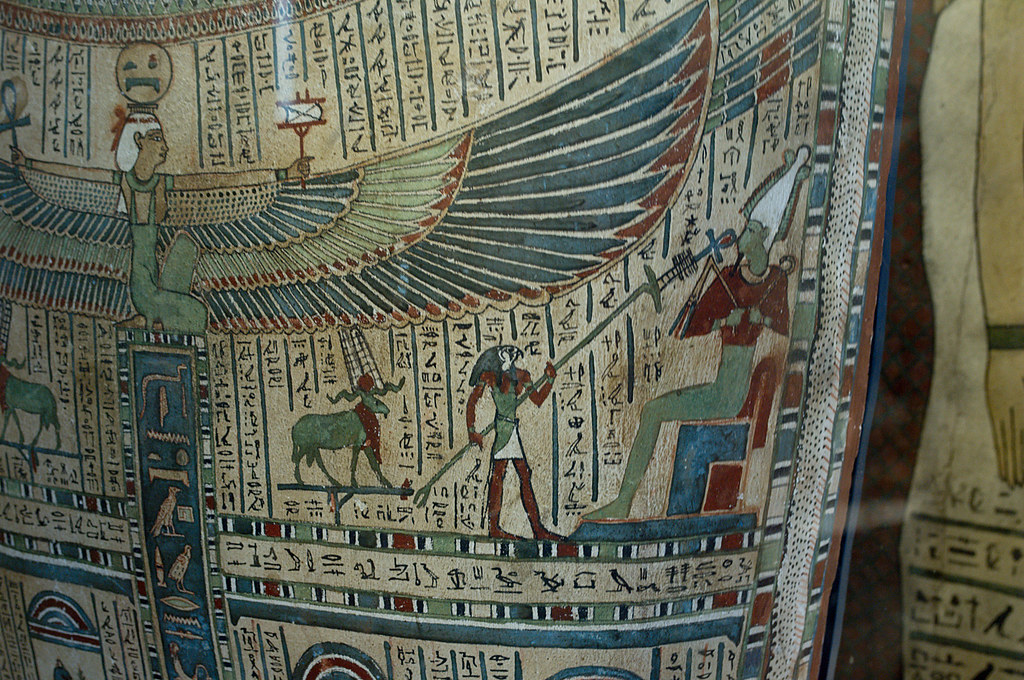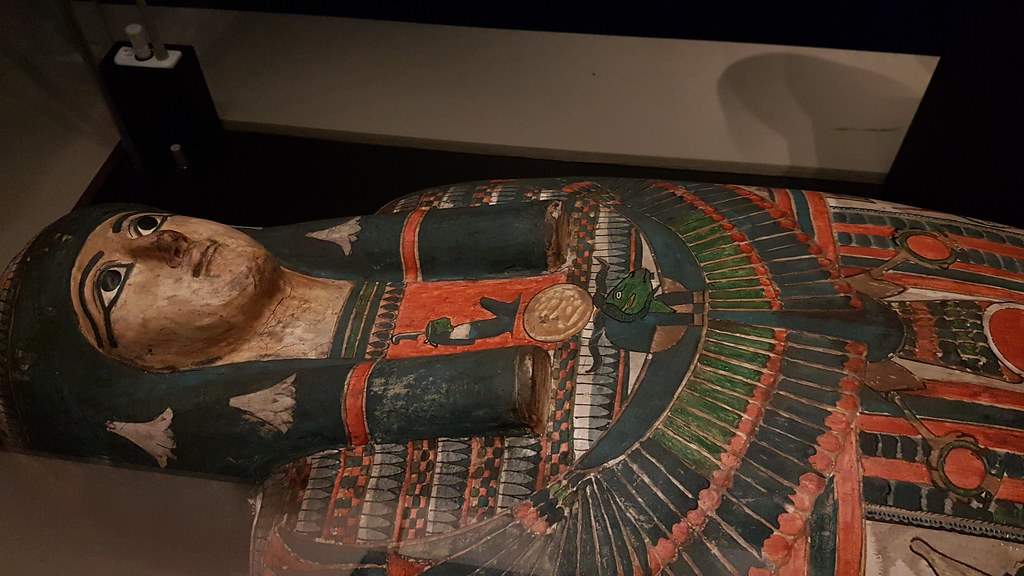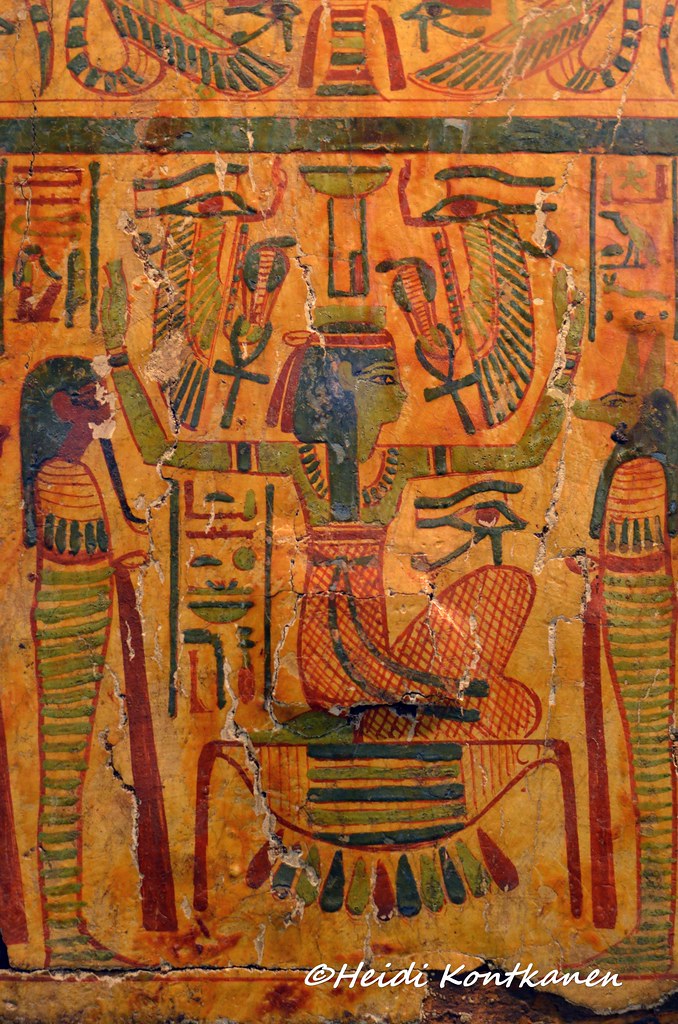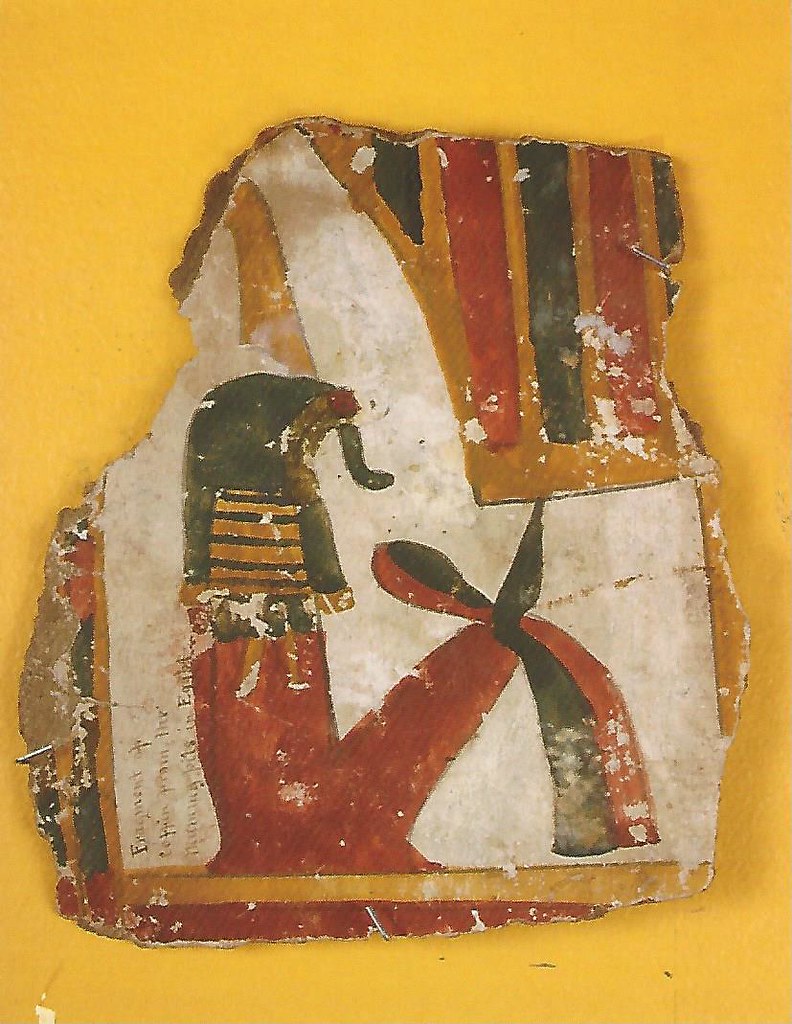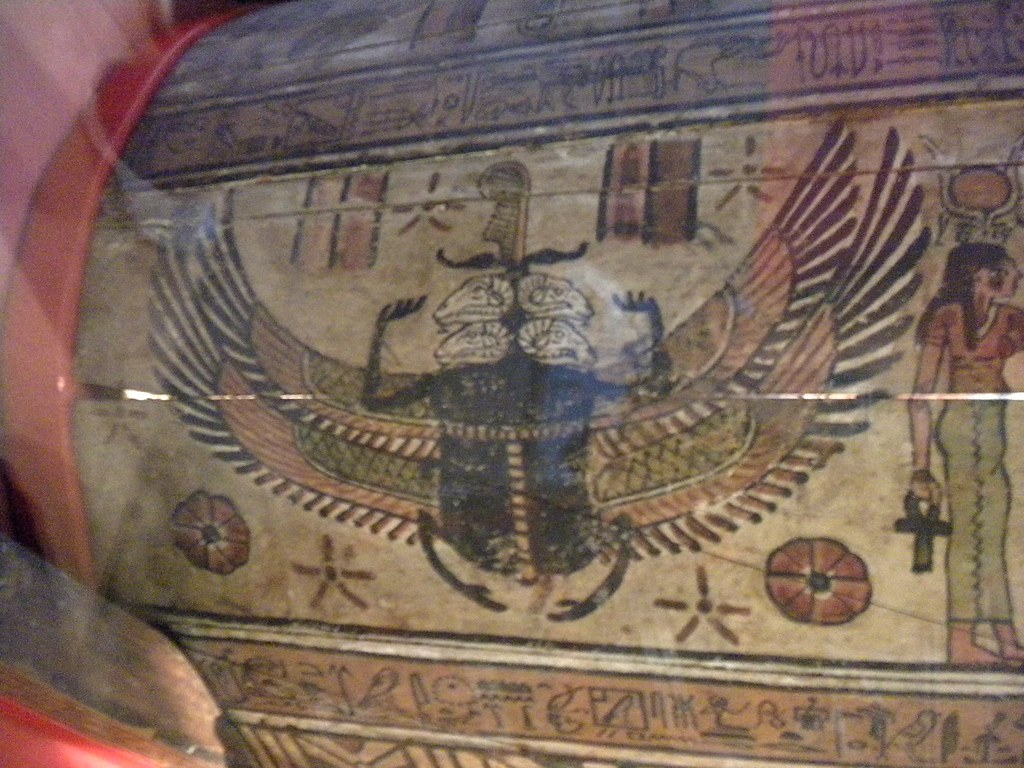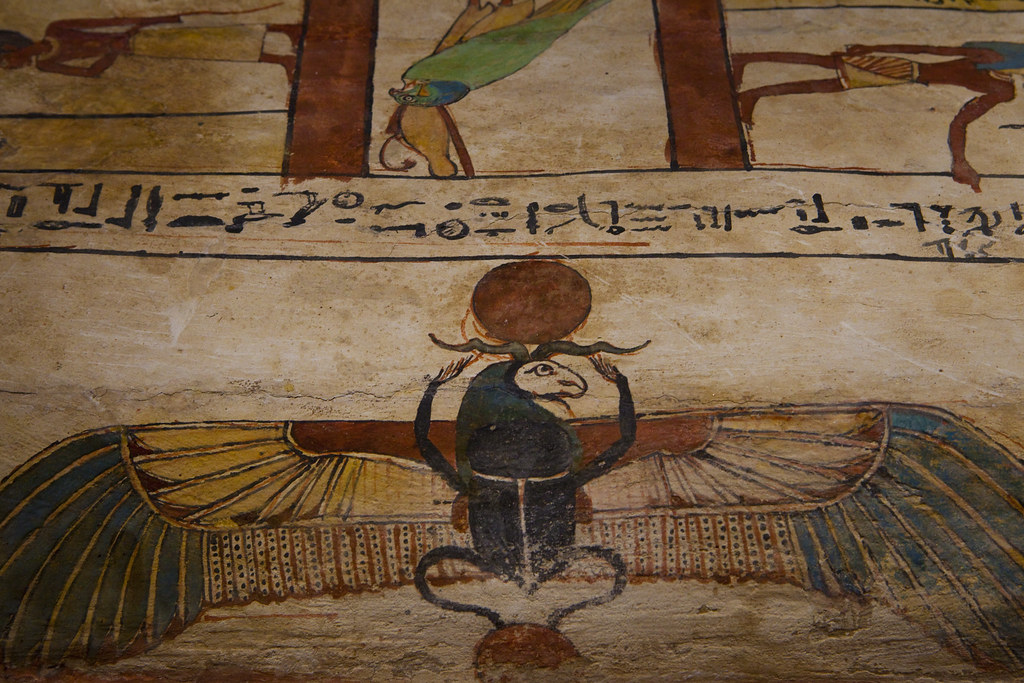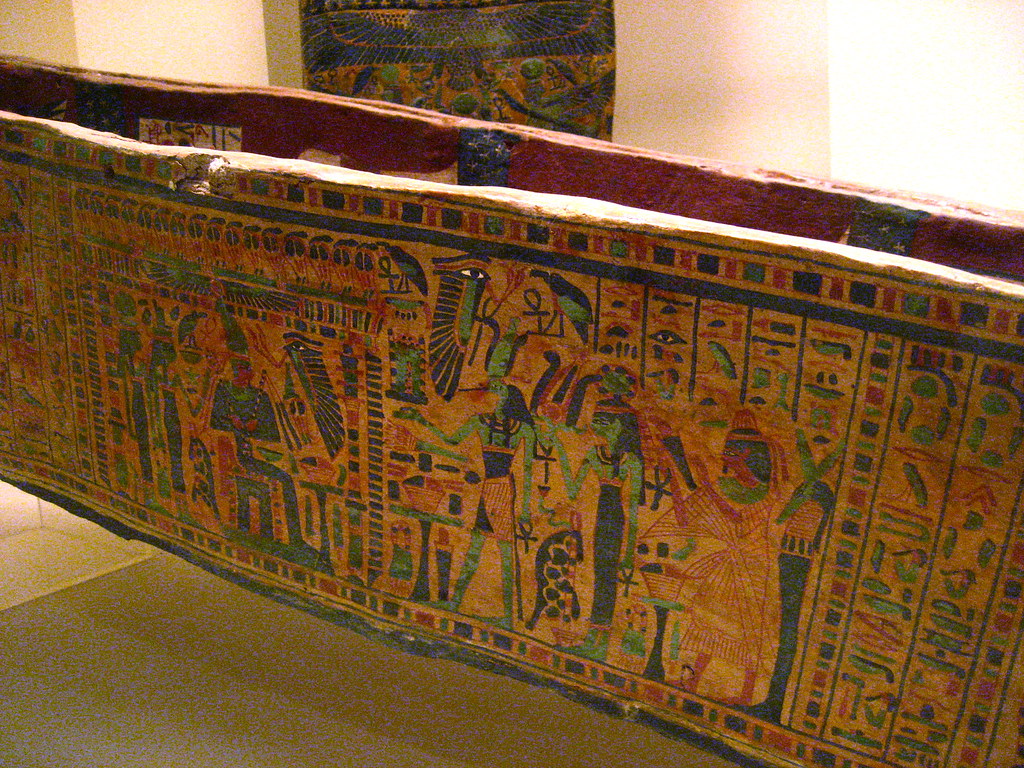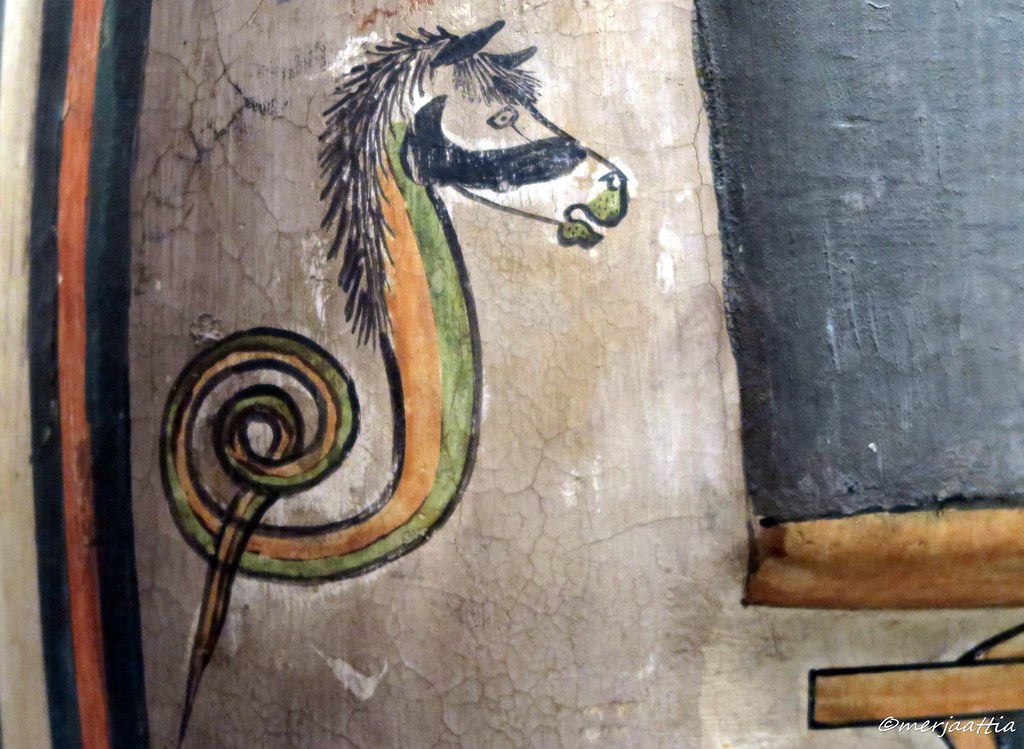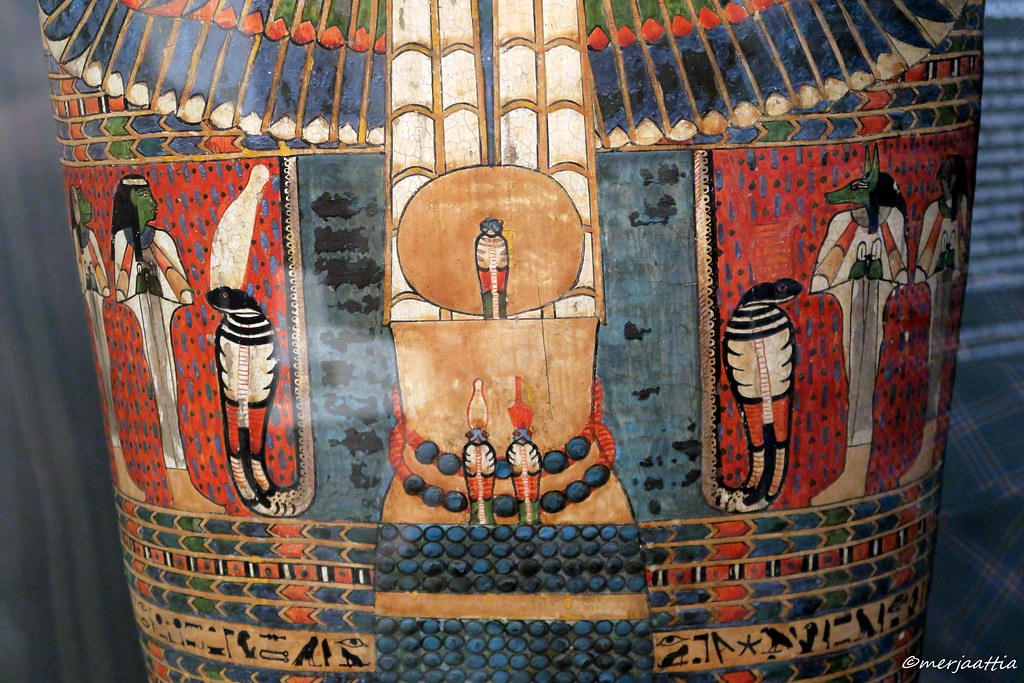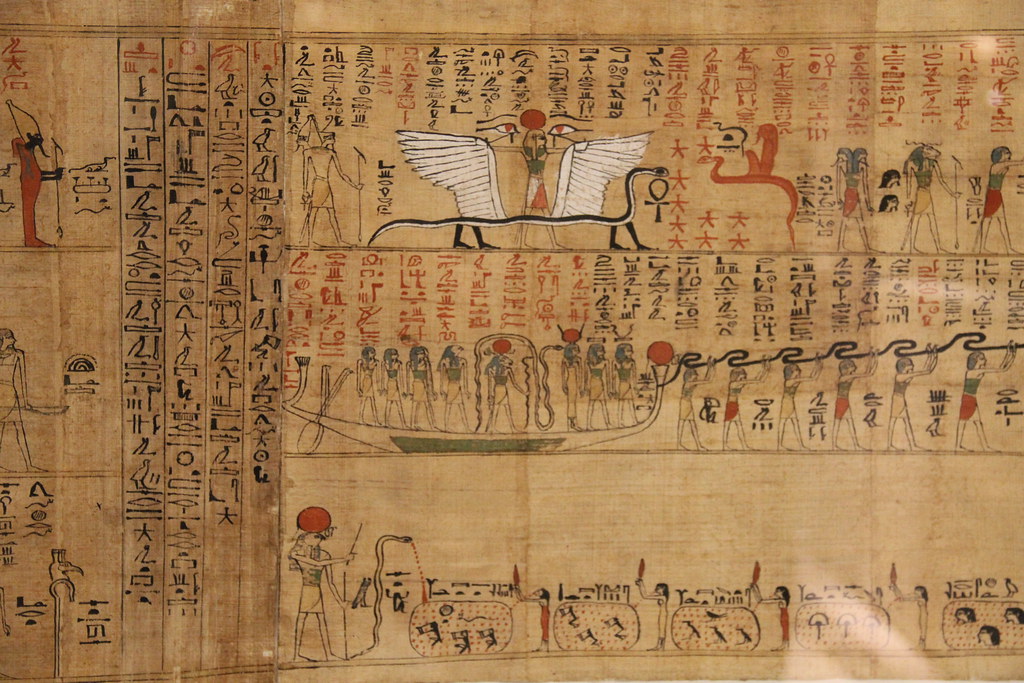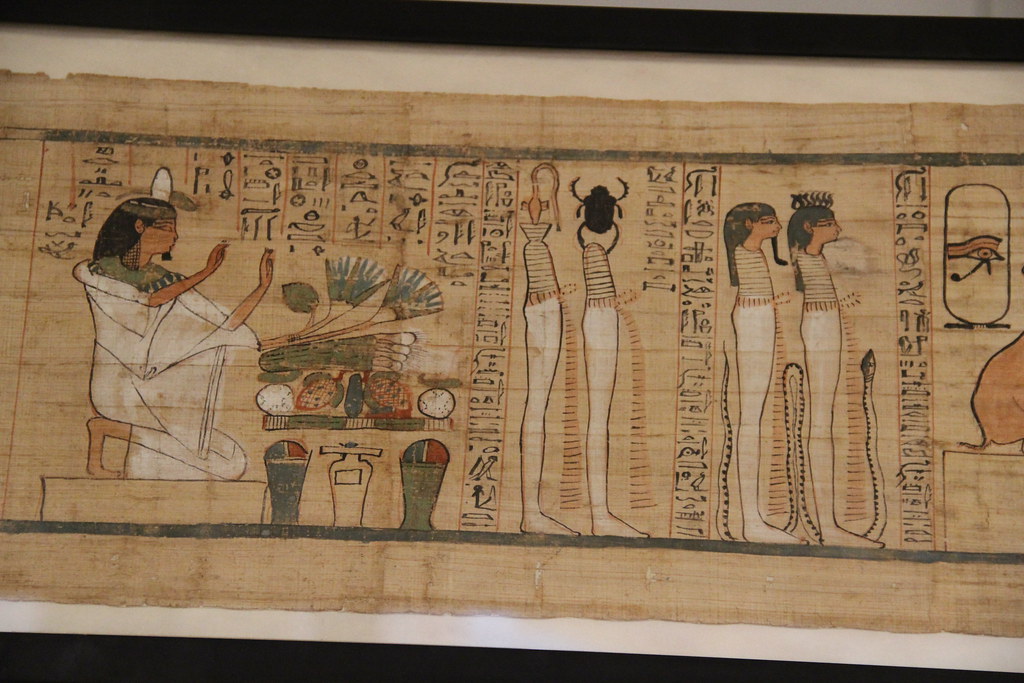Text
On Padiamun's coffin, The Devourer appears in the form of a dog, sitting at Thoth's feet as he records the result of the judgement. The deceased kneels behind Thoth, holding his heart. Anubis and Maat stand under the scales, and a large snake protecting Osiris in his pavilion rears up in front of Maat. Behind the pavilion we can see Imsety and Hapy, two of the sons of Horus.
Where: Liverpool World Museum
When: Third Intermediate Period, 25th Dynasty
#Ancient Egypt#coffin#Osiris#Anubis#Maat#Imsety#Hapy#The Devourer#Thoth#Liverpool World Museum#Third Intermediate Period#25th Dynasty#Padiamun
9 notes
·
View notes
Text
On the coffin of Oudjarenes, Horus offers his father Osiris the was sceptre with a djed column and an ankh on the tip. (Should we read this as "life, strength, health"?)
[An Egyptian coffin. On the right, Osiris is enthroned, and Horus is holding out a very long was sceptre topped by a djed column on top of which is an ankh; the ankh touches Osiris's nose. Behind Horus is a ram on a standard, wearing the double feather crown. The goddess Nut spreads her wings over the chest of the coffin; she holds an ankh in one hand and a ship's sail in the other, and there's a sun-disc on her head with her name in it.]
Where: Louvre
When: Late Period, 26th Dynasty
7 notes
·
View notes
Text
A satirical papyrus showing a lady mouse being served wine by a cat while another cat dresses her hair, a third cares for her baby, and a fourth fans her. The mice have hilarious huge, round ears.
Where: Egyptian Museum Cairo
When: New Kingdom
6K notes
·
View notes
Text
The coffin of Baketenhor, with a spectacular ram-headed falcon spreading its wings over her chest. Wings are black, green, and red, the ram's face is dark green, and it has a yellow sundisc on its head, above which sits a small figure of Maat.
Where: Natural History Society of Northumbria
When: Third Intermediate Period, 22nd Dynasty
ETA: Here's a hair-raising documentary about Baketenhor's mummy.
#Ancient Egypt#coffin#Natural History Society of Northumbria#Third Intermediate Period#22nd Dynasty#Baketenhor
10 notes
·
View notes
Text
On a yellow coffin, a black scarab with black wings lifts a pale green sundisc. Below is a frieze of black upside-down lotuses. To left and right stand two images of Osiris, green-skinned, wearing green white crowns.
Where: Egyptian Museum Cairo
When: Third Intermediate Period
23 notes
·
View notes
Text
Detail of the inner coffin of Nepawershefyt.
[On a yellow coffin, Nephthys kneels on the hieroglyph for gold, her arms raised above her head. On her left is Imsety and on her right, Duamutef, both as yellow mummies with green stripes. The goddess is green and so is Duamutef's jackal head.]
Where: Fitzwilliam Museum Cambridge
When: Third Intermediate Period, 21/22 Dynasty
#Ancient Egypt#coffin#Nephthys#Imsety#Duamutef#sons of Horus#Fitzwilliam Museum Cambridge#Third Intermediate Period#21st Dynasty#22nd Dynasty#Nepawershefyt
12 notes
·
View notes
Text
I can't tell you much about this small fragment of a coffin, except that it contains a seated deity with a snake's head, bearded, topped by a feather. There's a green and red length of cloth sort of balanced on his knee. He's painted in red, green, and gold, against a white background.
Where: Everhart Museum, Scranton, Pennsylvania
When: ?
3 notes
·
View notes
Text
On the coffin of Soter, a black scarab with four wings, four heads, and a crown made from wavy rams' horns and a maat feather. My guess is this complex figure is Banebdjedet, the god which represents the four souls of the sun god.
Where: British Museum
When: Roman Egypt
13 notes
·
View notes
Text
A detail from the coffin of Pa-debehu-Aset. The sun god appears as a black scarab with colourful wings and a ram's head with wavy horns, above which is a red sundisc. The scarab's hind legs also stand on a sundisc.
Where: Memorial Art Gallery, University of Rochester
When: Ptolemaic Egypt
6 notes
·
View notes
Text
The coffin of Tentkhonsu or Tenet-Khonsu.
[The side of a yellow coffin, painted in green, red, and black. Right to left: a mummiform god with a green donkey head; the deceased, red, making an offering; a green goddess with a green sundisc, holding an atef crown; a green Thoth, wearing an Atef crown; in a pavilion, red Osiris with crook, flail, and green-coloured white crown; green Isis; green goddess with green sundisc, presumably Nephthys.]
Where: Smithsonian National Museum of Natural History
When: Third Intermediate Period, 21st Dynasty
#Ancient Egypt#coffin#yellow coffin#Thoth#Osiris#Isis#Smithsonian#Third Intermediate Period#21st Dynasty#Tenetkhonsu
6 notes
·
View notes
Text
[A rectangular fragment of an unpainted coffin. At left, four naked gods with hands raised in worship; Heh and Nun have frog heads; Naunet and Hehet have uraeus heads. All appear male despite their labels. At right, a solar barque with multiple passengders, including a god with his arms raised above his head, holding a sun disc containing a scarab.]
Where: Hermitage Museum St Petersburg
When: Roman Egypt
9 notes
·
View notes
Text
[The white interior of a coffin lid, mostly illustrated in black ink. Two goddesses stand on either side of the pole of the Abydos reliquary, supporting it. Hieroglyphs run down the pole. Between each goddess and the pole is a ram on a standard, held up by an ankh with arms (left) and a was sceptre with arms (right). The base of the pole is protected by winged mummiform lions. Above each goddess Wepwawet stands on his shedshed symbol.]
What a great, complex diagram; despite the dearth of colour Ameneminet got his money's worth. These goddesses aren't labelled, but it would make sense if they were Isis and Nephthys.
21 notes
·
View notes
Text
From the coffin of Ameneminet. I glanced at an article in French about these "seahorses" on coffins -- I'll have to take another look.
THOMAS, Caroline. Le cheval-serpent, un curieux génie funéraire Revue d'Égyptologie 64, 2013
Where: Louvre
When: Third Intermediate Period, 22nd Dynasty
9 notes
·
View notes
Text
This is a detail of the coffin lid of Ameneminet. The Two Ladies, Nekhbet and Wadjet, appear twice as crowned ureai on this coffin lid (Nekhbet wears the white crown, Wadjet the red crown).
Where: Louvre
When: Third Intermediate Period, 22nd Dynasty
[An Egyptian coffin lid painted in red, black, blue, yellow, and green. In the centre is a yellow double-feathered crown with a sundisc protected by a uraeus; the Two Ladies sit below on a string of blue beads wrapped around the crown. On either side each of the Two Ladies faces two of Horus's sons.]
#Ancient Egypt#coffin#Wadjet#Nekhbet#sons of Horus#Louvre#Third Intermediate Period#22nd Dynasty#Ameneminet#E 5534
9 notes
·
View notes
Text
From the Amduat papyrus of Amenhotep.
Where: Neues Museum, Berlin
When: Third Intermediate Period, 21st Dynasty
[A wide view of the papyrus with several scenes, including the go who lifts the wings of the four-footed snake, and goddesses in red dresses spitting fire onto the condemned in pits.]
6 notes
·
View notes
Text
The Amduat papyrus of Nesyamennesettawy, who kneels at left before a pile of offerings. Four gods, forms of the great god who combines Osiris with Re, stand facing away from him; mummiform with white bodies, one has a brazier for a head, the next a scarab; the next two, who are trampling a snake, have human heads, but the second has a crown of tiny rearing snakes.
Where: Neues Museum Berlin
When: Third Intermediate Period, 21st Dynasty
#Ancient Egypt#papyrus#Amduat#Neues Museum Berlin#Third Intermediate Period#21st Dynasty#Nesyamennesettawy
7 notes
·
View notes
Text
Forms of Re on the Amduat papyrus of Tanetshedkhons. Surprisingly, the bound prisoner is also one of the forms of the sun god.
Where: Michael C. Carlos Museum
When: Third Intermediate Period, 21st Dynasty
[An Egyptian papyrus. Two rows of figures drawn in black and painted in red and yellow, between columns of black hieroglyphs. They include a yellow cat sitting on a plinth; below him, an Asiatic prisoner with arms pinioned behind him, kneeling on a plinth.]
#Ancient Egypt#papyrus#Amduat#Michael C. Carlos Museum#Third Intermediate Period#21st Dynasty#Tanetshedkhons
19 notes
·
View notes

